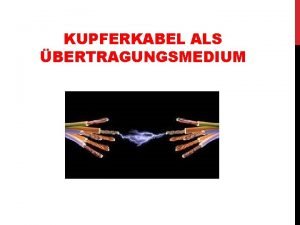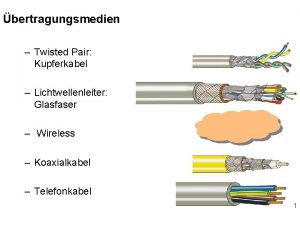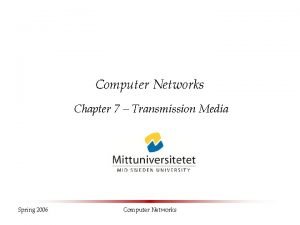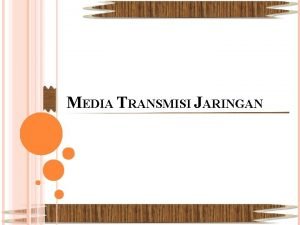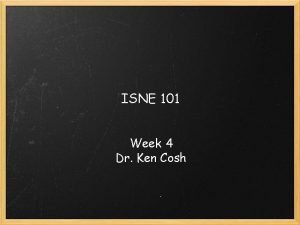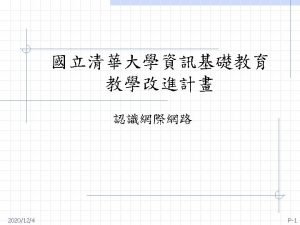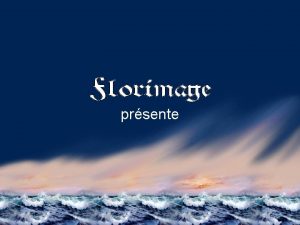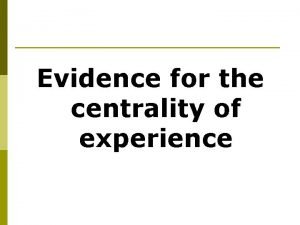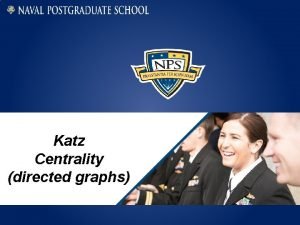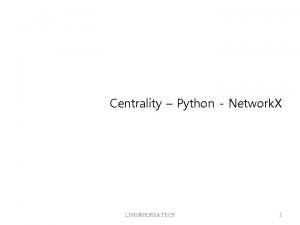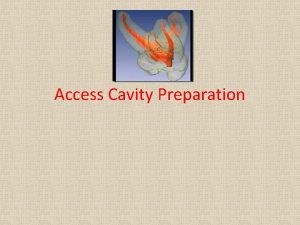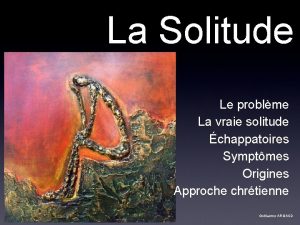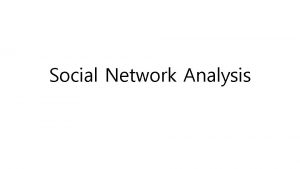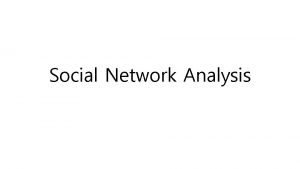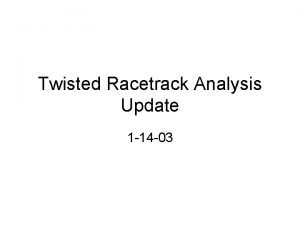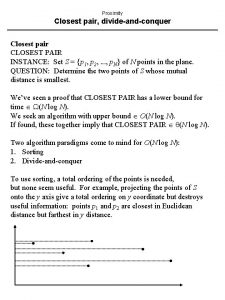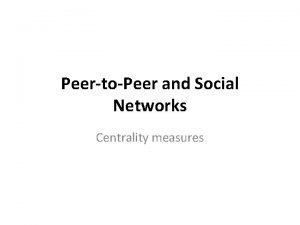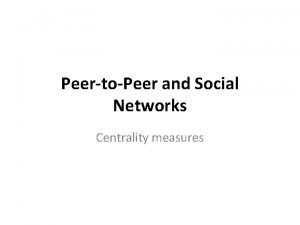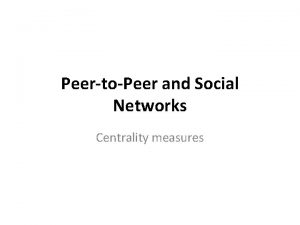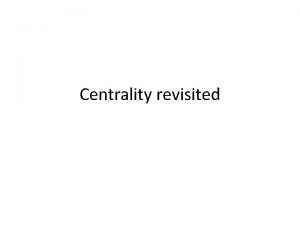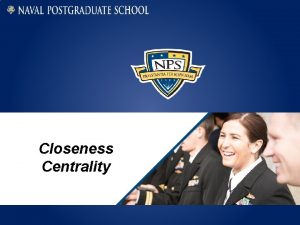A Twisted Pair Solitude and Network Centrality as



















- Slides: 19

A Twisted Pair: Solitude and Network Centrality as Creativity Drivers Anna Fedorova, Ph. D Candidate Monica Calcagno, Associate Professor For BAM 2020

Not so Social Networks: Does Solitude Make Us Creative? • Inspiration behind this artcile: an attempt to view creativity as collective condition vs. individual dimension • Caused by the clash of management literature and personality literature that tend to view creativity from sometimes opposed angles • Exploratory attempt to bridge two domains on examples of social and solitary sides of individual creativity • Creativity stands for development of outputs that are novel and useful, simultaneously (Amabile, 1996)

social side of creativity • In social sciences: Creativity is classically considered a socially situated phenomenon (Csikszentmihalyi, 1988; Amabile, 1988) • Creativity doesn’t exist without others: they inspire us to be creative, help to maintain creativity, and receive our creative outputs, thus we need to be socially connected • Social environment is a pool of necessary domain specific information, a source of extrinsic motivation and necessary support

social side of creativity • Social networks (SN): structural representation of workplace interactions in the organization • In SN, creativity is known to be driven by degree centrality: number of direct ties • How degree centrality affects creativity: masters the exploitation of social capital attracts resources and support increases inflow of useful information helps optimize the creative process eases legitimacy pursue

personality • While social environments externally affects individual creativity, personality traits drive it from within • Creative tasks are not alike: different disciplines attract dissimilar personalities • Example (taken from meta-analysis study by Feist, 2006): social scientists are more creative when extraverted; mathematicians and scientists are more creative when introverted! • Examples from history of art and science: the famous lone genius myth (Storr, 1988) • Some tasks require deep concentration and networking can become a hindrance (Wolfradt, 2001) • Organizational Behavior evidence: brainstorming sessions can originate worse ideas than time alone (e. g. , Putman and Paulus, 2009)

solitude • Creativity can be enhanced in solitude (Storr, 1988) • solitude: disengagement from instant communication with other people, which does not require physical separation • controversial standing in the literature: negative side - depression, loneliness, boredom, historical measure of punishment (e. g. Larson, 1990, Suedfeld, 1974) positive functions - self-discovery, problem solving, creativity (Long et al. , 2003) • When experienced voluntary, solitude can: bring deeper concentration, full immersion into creative task help escape disturbance help find calmness and comfort

solitude • Preference for solitude (Pf. S): desire do be alone in order to become engaged in an activity that has intrinsic appeal (Marcoen and Goossens, 1993 • People with high Pf. S in organisations: produce innovative outputs independently, without much external stimuli or active networking • Topicality of Pf. S at the era of digitalisation: people escape communication and find solitude in social media (Hill and Zheng, 2017) • Topicality of Pf. S at COVID-19 times: people with Pf. S are less likely to become inefficient quarantine and emotionally uncomfortable during the

aim of the study and RQ The purpose of the study is to integrate social and solitary sides of individual creativity in interpersonal networks RQ: how do network centrality and Pf. S, entwined, affect creativity?

high Pf. S People with high Pf. S: • tire, bore and stress from active interaction • rely on intrinsic resources • need to be undisturbed to polish up ideas • are happy and productive in solitude In SN: • desire low degree centrality: less time communicating, more time alone • suffer from high degree centrality: exuberant interaction can bring discomfort • need more privacy, suffer in collaborative environment

high Pf. S Hypothesis 1: Individuals with higher levels of Pf. S rely on intrinsic resources at work, thus their creative performance will be positively associated with Pf. S. Hypothesis 2: For individuals with high Pf. S, the relation between Pf. S and creative performance will be negatively moderated by degree centrality. Hypothesis 3: For individuals with high Pf. S, collaborative environment performance. will have a negative impact on creative

low Pf. S Low Pf. S’s: • seek active communication • responsive to extrinsic stimuli • benefit from brainstorms and discussions • are ready to receive and use the information • feel unhappy and unproductive in solitude In SN: • desire high degree centrality: need for information, support, extrinsic motivation • feel uncomfortable and under nurtured in case of low degree centrality • are comfortable in collaborative environment

low Pf. S Hypothesis 4: Individuals with lower levels of Pf. S rely on extrinsic resources at work, thus their creative performance will be positively associated with degree centrality. Hypothesis 5: For individuals with low Pf. S, the relation between degree centrality and creative performance will be negatively moderated by Pf. S. Hypothesis 6: For individuals with low Pf. S, collaborative environment performance. will have a positive impact on creative

research design & setting • R&D department in a large company engaged in gas machinery industry in Russia • in line with prior research that used similar R&D settings for network creativity studies (e. g. , Li et al. , 2018; Soda et al. , 2019) • 83 employees in design engineering department (3 D drawings of future products) • engineering creativity: the driver of technological progress • high technological sophistication, final output is material object => potentially important role of Pf. S trait • necessity of collaboration in team projects, complementarity of produced outputs + low employee turnover => appropriate setting for SNA research

data collection procedures • Preliminary interviews with managers • On-site data collection in May 2019 • Web-based collection of the missing responses in August 2019

variables • Creative performance: Integrated Creativity Scale (Oldham & Cummings, 1996) • Pf. S: Pf. S scale by Burger (1995) • Degree centrality: advice network roster, average of 4 matrices • Collaborative environment: from managers interviews • Controls: tenure, job rank

results Hypothesis 1: Individuals with higher levels of Pf. S rely on intrinsic. YES resources at work, thus their creative performance will be positively associated with Pf. S. NO Hypothesis 2: For individuals with high Pf. S, the relation between Pf. S and creative performance will be negatively moderated by degree centrality. YES Hypothesis 3: For individuals with high Pf. S, collaborative environment will have a negative impact on creative performance. Hypothesis 4: Individuals with lower levels of Pf. S rely on extrinsic. YES resources at work, thus their creative performance will be positively associated with degree centrality. Hypothesis 5: For individuals with low Pf. S, the relation between degree centrality and creative performance will be negatively moderated by Pf. S. NO Hypothesis 6: For individuals with low Pf. S, collaborative environment will. NO have a positive impact on creative performance.


Not so Social Networks: Does Solitude Make Us Creative? Important findings: • people with low Pf. S are more creative when they hold central positions in the network • highest levels of creativity are achieved by people with high Pf. S and high network centrality • both categories encountered lower creativity levels when they were placed in a collaborative environment Contributions: • introduce a new personality trait to the domain of intra-organisational networks • complementarity of seemingly contradicting arguments • draw attention to importance of contextualization of social network research

«…the less information your brain receives, the harder your imagination works» Joseph Brodsky, Nobel laureate in Literature Thank you!
 Kupferkabel nachteile
Kupferkabel nachteile Kupferkabel aufbau
Kupferkabel aufbau Stp ftp utp
Stp ftp utp Application of twisted pair cable
Application of twisted pair cable Gambar kabel twisted pair
Gambar kabel twisted pair Cosh-101
Cosh-101 G.hn over twisted pair
G.hn over twisted pair Coaxial cable twisted pair fiber optic
Coaxial cable twisted pair fiber optic Hash collision
Hash collision Dof of screw pair
Dof of screw pair Se sentir seule
Se sentir seule Page rank centrality
Page rank centrality Buendia family tree
Buendia family tree What is abstract in writing
What is abstract in writing Centrality of experience
Centrality of experience Katz centrality networkx
Katz centrality networkx Degree centrality python
Degree centrality python Brain gain definition ap human geography
Brain gain definition ap human geography Mandibular molar access opening
Mandibular molar access opening Constant solitude meaning
Constant solitude meaning
